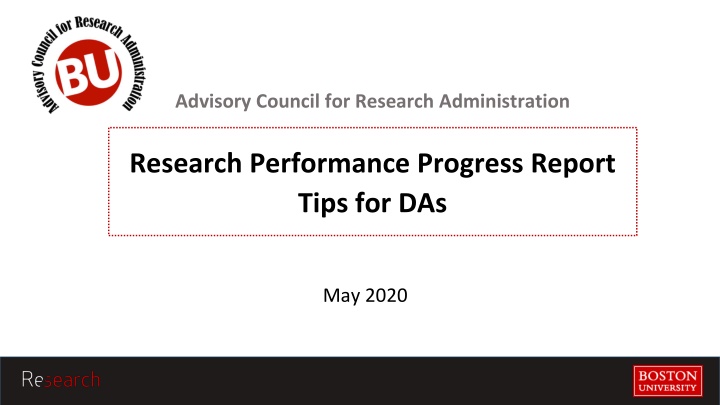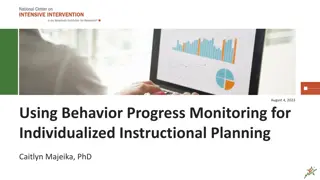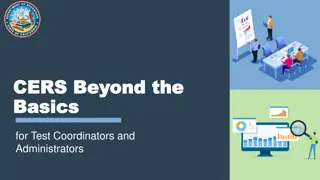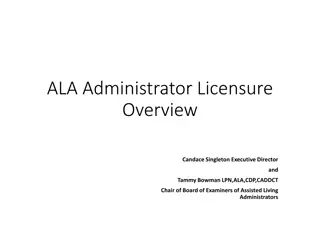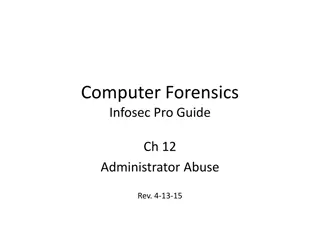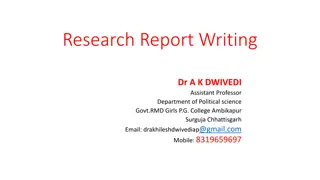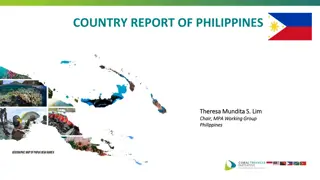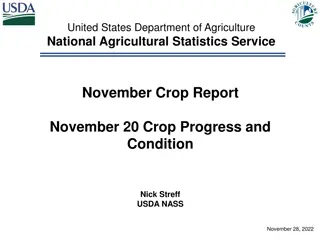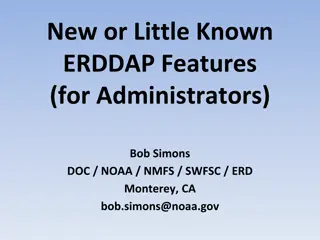Research Progress Report Tips for Department Administrators
Includes information on roles and responsibilities, process triggers, reviews, and compliance checks related to research performance progress reports. Helpful tips provided by presenters from various departments.
Download Presentation

Please find below an Image/Link to download the presentation.
The content on the website is provided AS IS for your information and personal use only. It may not be sold, licensed, or shared on other websites without obtaining consent from the author.If you encounter any issues during the download, it is possible that the publisher has removed the file from their server.
You are allowed to download the files provided on this website for personal or commercial use, subject to the condition that they are used lawfully. All files are the property of their respective owners.
The content on the website is provided AS IS for your information and personal use only. It may not be sold, licensed, or shared on other websites without obtaining consent from the author.
E N D
Presentation Transcript
Advisory Council for Research Administration Research Performance Progress Report Tips for DAs May 2020
Agenda Presenters Rachelle Joseph, School of Medicine Meredith Hanna, School of Public Health Sophia Zhang, Post Award Financial Operations Michael Gooley, College of Arts & Sciences Chris Sylvester, Sponsored Programs Roles & responsibilities Departments Sponsored Programs Post Award Financial Operations Department and Central Communications Best practices Unobligated balance Subcontracts Other Support ASSIST for Human Subjects Publications 2
Department Roles & Responsibilities It is the PI s responsibility to complete the annual and final reporting requirements per the terms of the award. It is recommended that PIs work with department grant/research administrators to complete the following information: Personnel Effort (w/ complete eRA Commons Profile) Updated Other Support Unobligated Balance/ Budget (if required) Subcontract documentation My NCBI compliance Helpful Links: RPPRs: Who Does What? 3
Sponsored Programs Process Trigger for SP review of RPPR RPPR routed to Diane Baldwin in eRA Commons Department Administrator sends RSF (RPPR Summary Form) via email to SP RA 4
SP View of the RPPR RPPR PDF RPPR Menu Screen 5
SP View of the RPPR (cont) HSCT Record in ASSIST 6
SP Review SP review of RSF SP review of RPPR Content and formatting of attachments Content of fillable fields in the RPPR Compliance with publication policy (Section C) Compliance with effort reporting requirements (Section D) Compliance with reporting on human subjects enrollment (section G) Compliance with reporting unobligated balance (section G) If necessary, review of budget included in non- SNAP RPPR Any changes to subs, do we have the updated paperwork? Unspent balance in line with what is noted in SAP? Changes in effort align with what is reported in RPPR? PI Certifications- do they align with what is reported in RPPR? Appropriate signatures on RSF? 7
SP Pain Points During Review PI effort reduction greater than 25% from submission levels Publication Compliance Human Reporting unobligated balance Subjects/Clinical Trials information in ASSIST 8
SP Submission RPPR and RSF have been reviewed and approved by SP PI is notified that RPPR is ready for submission Once PI approves, RPPR is submitted to the sponsor via eRA Commons 9
Post Award Financial Operations PAFO RA will work with the DA and the SP RA to confirm final balances and unobligated balances To assist with consistent calculation of the unobligated balance, use the Unobligated Calculator as the attached excel worksheet 10
Department and Central Communications Department DA contacts SP for RPPR review and submission SP will contact DA if questions on reported figure DA can reach out to PAFO RA to confirm balance before submitting RPPR for SP review SP RA PAFO RA Discuss unobligated balance at time of RPPR SP confirms with PAFO if unobligated balance greater than 25% Discuss revised numbers ahead of submission 11
Unobligated Balance Calculation for RPPR #1 The DA can support PI response on anticipated unobligated balance. Project out expenses through end of current grant year If there are Subawards, coordinate with PI over progress of subaward recipients. Calculate Current Obligated Available Budget (current segment plus any approved unobligated budget carried forward from previous year(s)) Projected Current Year-end Total Cost Balance = % Projected Unobligated Balance at year end Current Year Approved Budget x 100 13
Multiple IO numbers Calculator The total approved budget includes the amount awarded for the current year and any carryover from the previous budget period. If the unobligated balance is greater than 25% of the total approved budget, the PI must provide an explanation and a plan for expenditure of those funds in the next budget period. 14
Unobligated Calculator excel worksheet (Modual Grant) In accordance with Section 8.1.1.1 of the NIH Grants Policy Statement, recipients of NIH grant awards under the SNAP mechanism are required to report, as part of the grant s progress report, whether the estimated unobligated balance (including prior year carryover) is expected to be greater than 25% of the current year s total approved budget. 15
Unobligated Calculator excel worksheet (non Modual Grant) 16
Subcontracts #2 When completing an RPPR for an award with subcontracts, PIs or department research administrators should request the following information from each subcontract PI several weeks in advance of the deadline to allow time for each institution to prepare the reports: ACTIVE Other Support for sub-award PI and all key personnel Personnel Report info. for all personnel devoting effort in current budget year Unobligated balance for the current grant year and, if balance is >25%, an explanation and a justification of how it will be used in the upcoming grant year Detailed budget and justification (for grants that require a budget) *scientific reports are submitted directly to the PI from the subrecipient 17
Subcontracts - Helpful Tips ACTIVE Other Support Personnel Report Unobligated Balance Budget Prime PI should provide to the subaward PI the anticipated total $ amount to be allocated to the subaward for the upcoming grant year (noting it is possible this could change if the overall award were reduced due to NIH policies). If this anticipated total $ amount is less than the originally request $ amount, explain why (i.e. such as overall awarded budget was reduced). For grants that require a budget to be entered into the RPPR, request detailed subaward budget, including justification. Consider attaching a blank copy of the standard subaward budget form and the budget originally submitted (or the budget submitted with the previous year RPPR) for their reference/ease in completing. Request for all personnel devoting effort in the current grant year, noting that a Commons ID and complete profile is required for Key individuals, postdocs and grad students. Consider attaching, for their ease, a blank copy of the old paper Personnel Report. Request the approximate $ amount of any anticipated balance in the current grant year and, if an anticipated balance is >25%, request an explanation of why there is a balance and a justification of how it will be used in the upcoming grant year (whether this needs to be incorporated into the overall RPPR will depend on whether the overall grant balance is >25% and how large a portion the subaward is of the overall budget and balance). Request in Word, in case edits are needed and so that it can be combined with Other Support of other investigators. If available, consider attaching the Other Support document that was provided the last year, or for JIT, to try to make it simpler for them. 18
Other Support #3 At the time of Progress Report an updated other support page is required for: New Senior/Key Personnel Changes in Other Support that result in effort being reduced by 25% or more on the project Other Support includes all financial resources, whether Federal, non-Federal, commercial or institutional, available in direct support of an individual's research endeavors, including but not limited to research grants, cooperative agreements, contracts, and/or institutional awards, foreign resources. (Training awards, prizes, or gifts do not need to be included.) 19
Other Support Helpful Tips Remind Investigators of the original effort proposed Provide Investigators with their Other Support Document from JIT/prior year RPPR in word format so they can easily edit Information for all other support pages should be consistent in format (i.e. font size, direct cost vs. total cost) Report the total annual amounts for awards, including subcontracts Be sure to include overlap statements that outline the scientific overlap or need for reduction in effort on specific projects Use (THIS AWARD) for the award being reported. (NEW) for any new awards not previously reported. (Effective March 2020) 20
Other Support (cont.) The NIH monitors the Other Support pages across various projects for all Senior/Key Personnel. Inaccurate information may result in delays or restrictions to the Notice of Award. Visit the NIH website for the most up to date version of the Other Support Format page. (https://grants.nih.gov/grants/forms/othersupport.htm) 21
Human Subjects and Clinical Trials Post-Submission Records and RPPRs #4 Human Subject information and enrollment is now reported via ASSIST. HSCT record is accessed via a link embedded in section G.4 of the RPPR. At the time of RPPR, only the Inclusion/ Enrollment report must be updated, unless study is a clinical trial. Once the HSCT Study record is updated and saved, alert SP RA. SP RA will review updated record. Once updated Study Record is reviewed, it can be submitted for inclusion in the RPPR. For further details on the use of the ASSIST HSCT function, see these instructions. 22
Publications and NIH Public Access Policy Compliance #5 Common Questions How long does it take for a publication to come into compliance? What happens if an RPPR is submitted with a non-compliant publication? What is the NIH Public Access Policy? this resource See this resource for further details. What falls under the NIH Public Access Policy? this webpage See this webpage for assistance concerning your publications. How can I tell if a publication is compliant? this webpage See this webpage for an explanation of the different compliance statuses. How is a paper submitted to NIH for PMC processing? this resource See this resource for complete instructions. 23
Questions? 24
